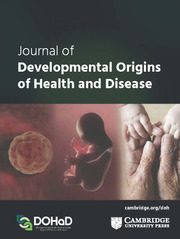No CrossRef data available.
Article contents
The effects of maternal body weight on iodine concentration in breast milk and cord blood and infant growth
Published online by Cambridge University Press: 30 January 2025
Abstract
Breast milk (BM) is the only source of iodine and bioactive compounds that influence growth and development in infants. The content of BM may be influenced by maternal body mass index (BMI). The aim of this study was to investigate the effect of maternal weight on BM and cord blood iodine concentrations, growth-related hormones, infant anthropometric measurements. A total of 84 mother-infant pairs participated. Levels of leptin, adiponectin and insulin-like growth factor-I (IGF-I) in postnatal BM and cord blood were analysed by enzyme-linked immunosorbent assay (ELISA), iodine by Sandell-Kolthoff reaction. Dietary iodine intake of women was determined by food frequency questionnaire, and anthropometric measurements of infants at birth and 3 months were evaluated. Dietary iodine intake was found to be similar in normal weight (NW) and overweight/obese (OW/OB) women (p > 0.05). Breast milk iodine concentration (BMIC) was 17.4 μg in NW, 18.2 μg in OB/OW women. Adiponectin in cord blood and IGF-I in BM were higher OB/OW than NW women (p < 0.05). Positive correlations were found between the infant birth weight and adiponectin in BM, between the infant body weight at 3 months and leptin and adiponectin in BM, between the infant birth head circumference and IGF-I in BM (p < 0.05). In multiple linear regression model, leptin and adiponectin in BM had a positive effect on infant body weight (p < 0.05). Maternal BMI may influence infant body weight via leptin and adiponectin in BM and infant head circumference via IGF-I. No relationship was found between maternal BMI and iodine levels and anthropometric measurements of the infant. Longitudinal studies are recommended to understand the effect of BMIC on growth.
- Type
- Original Article
- Information
- Copyright
- © The Author(s), 2025. Published by Cambridge University Press in association with The International Society for Developmental Origins of Health and Disease (DOHaD)



